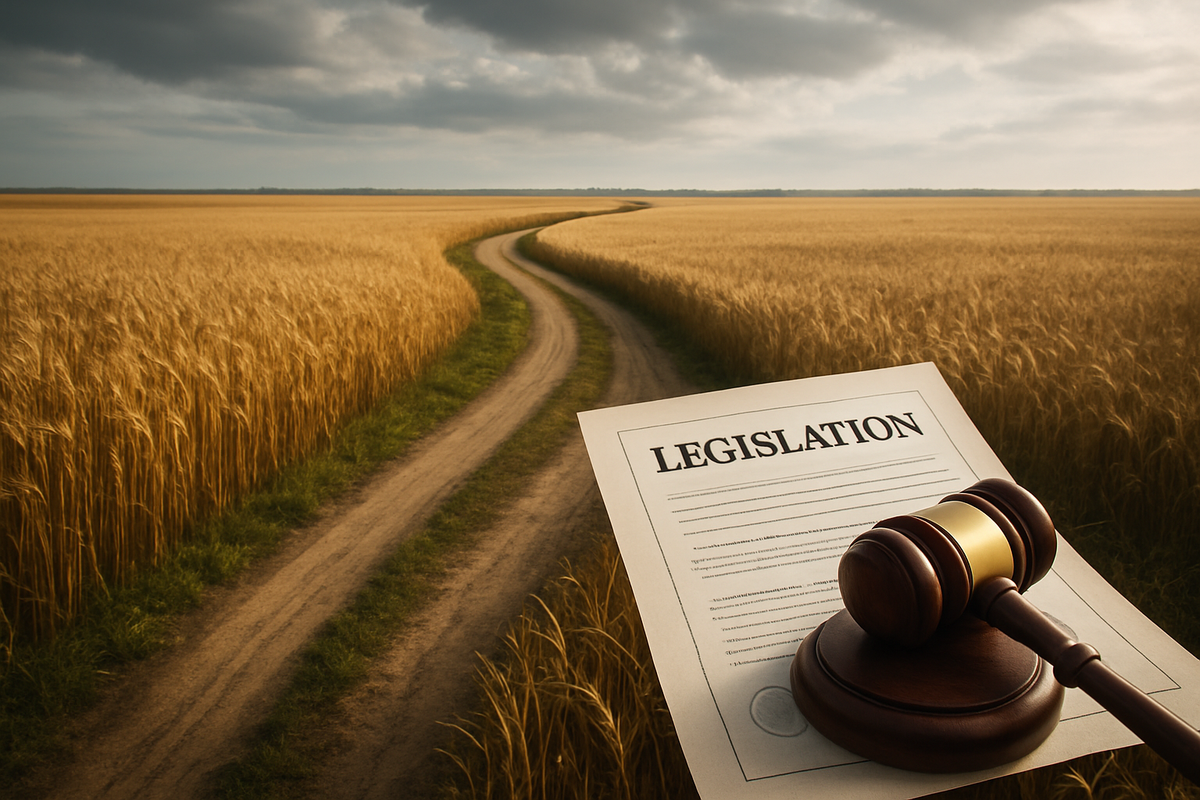Farm Bill Crossroads: Uncertainty Looms as 2018 Legislation Expires Amidst Sweeping Reforms

Washington D.C., November 5, 2025 – The bedrock of American agricultural policy, the 2018 Farm Bill, has officially expired, casting a long shadow of uncertainty over the nation's farmers, food systems, and financial markets. While a significant portion of agricultural provisions were addressed by the "One Big Beautiful Bill Act" (OBBBA) in July 2025, a comprehensive, new five-year Farm Bill remains elusive. This legislative limbo, marked by partisan divides and a complex interplay of extensions and reconciliation efforts, leaves critical programs unfunded and stakeholders grappling with a redefined landscape.
The expiration of the extended 2018 Farm Bill on September 30, 2025, coupled with the selective nature of the OBBBA, has created a two-tiered system of agricultural policy. Major commodity programs and tax benefits are largely secured through 2031, providing a degree of stability for large-scale producers. However, a wide array of conservation initiatives, nutrition assistance programs, rural development projects, and support for specialty crops now face an uncertain future, prompting calls for a "skinny Farm Bill" to address these critical gaps. The ongoing legislative stalemate is unfolding against a backdrop of severe financial stress for many farmers, who are contending with persistently high input costs and volatile commodity prices, making the need for clear and stable policy more urgent than ever.
A Legislative Labyrinth: Extensions, Reconciliation, and Unfinished Business
The journey to the current Farm Bill predicament has been protracted and fraught with political challenges. The Agriculture Improvement Act of 2018, initially set to expire on September 30, 2023, received its first one-year extension in November 2023. As 2024 progressed, efforts to draft a new comprehensive bill stalled in both the House and Senate due to deep disagreements over funding and policy priorities.
Facing continued inaction, Congress enacted a second one-year extension on December 21, 2024, through the "American Relief Act, 2025," pushing the expiration date to September 30, 2025. This act also provided $31 billion in disaster aid and market relief to agricultural producers. However, the most significant development of 2025 arrived on July 4, with the signing of the "One Big Beautiful Bill Act" (OBBBA) (P.L. 119-21). Passed via budget reconciliation, OBBBA dramatically reshaped the Farm Bill landscape, extending key commodity support programs like Agriculture Risk Coverage (ARC), Price Loss Coverage (PLC), and Dairy Margin Coverage (DMC) through the 2031 crop year. It also enhanced crop insurance and provided roughly $66 billion for American agriculture over the next decade. Crucially, OBBBA also made permanent several provisions from the 2017 Tax Cuts and Jobs Act (TCJA), including lower individual income tax rates and the 20% qualified business income (QBI) deduction, offering substantial tax benefits to farmers.
Despite its broad scope, OBBBA notably included deep cuts to the Supplemental Nutrition Assistance Program (SNAP) by $186 billion over 10 years, a move that has severely strained the traditional bipartisan coalition necessary for passing a comprehensive Farm Bill. As of October 2025, the U.S. Senate failed to pass a continuing resolution that included another Farm Bill extension, leaving many programs without legal authority. Discussions are now focused on a "skinny Farm Bill" to address the remaining 20% of provisions not covered by OBBBA, including many conservation programs, rural development, agricultural research, forestry, and horticulture/specialty crops. Without further action by January 1, 2026, the specter of "permanent law" from the 1930s and 1940s looms, a scenario widely viewed as catastrophic for modern agriculture.
Key players in this ongoing legislative drama include the House Committee on Agriculture, chaired by Glenn "GT" Thompson (R-PA), and the Senate Committee on Agriculture, Nutrition, and Forestry, led by John Boozman (R-AR). Agricultural advocacy groups like the American Farm Bureau Federation and National Farmers Union are vocal proponents of a stable, comprehensive bill, while nutrition advocates such as the Food Research & Action Center (FRAC) are fiercely opposing SNAP cuts. Initial market reactions have been characterized by widespread farmer uncertainty, as many programs they rely on lack long-term certainty. The fixed statutory reference prices for commodities, until updated by OBBBA, were increasingly out of sync with soaring input costs, leaving farmers in a "severe financial squeeze."
Winners and Losers: A Shifting Agricultural Landscape
The current Farm Bill legislative environment, particularly the influence of OBBBA, is creating distinct winners and losers across the agricultural and related industries.
On the winning side are large-scale commodity producers and the agribusinesses that supply them. OBBBA's provisions significantly boosted commodity programs, raising statutory reference prices for major crops like corn, wheat, and soybeans, and modifying formulas for Price Loss Coverage (PLC) and Agriculture Risk Coverage (ARC) programs. Farmers can now receive the higher of ARC-CO or PLC payments for 2025, providing a more robust safety net. Payment limits for Title 1 commodity programs also increased from $125,000 to $155,000, indexed for inflation. This benefits companies like Deere & Company (NYSE: DE), a leading agricultural machinery manufacturer, which could see increased demand for equipment and precision agriculture technologies. Similarly, major producers of seeds, crop protection products, and fertilizers such as Corteva Agriscience (NYSE: CTVA), Nutrien Ltd. (TSX: NTR), and The Mosaic Company (NYSE: MOS) are likely to experience stable or increased demand as enhanced commodity support encourages consistent planting. Crop insurance providers also stand to benefit from enhanced support and increased demand for comprehensive coverage, as these programs are permanently authorized and were further strengthened by OBBBA. Biofuel producers, such as Green Plains Inc. (NASDAQ: GPRE), are also poised to benefit from the OBBBA's extension of the crucial 45Z biofuels credit.
Conversely, small and mid-sized farmers, specialty crop producers, and organic farmers are likely to be disproportionately impacted. The deep cuts to SNAP in OBBBA translate to reduced consumer purchasing power, indirectly harming local and regional food systems that often rely on these smaller farms. Many "orphan programs" — those supporting beginning farmers, socially disadvantaged farmers, and specialty crops — have lost their funding with the expiration of the extended 2018 Farm Bill and were not covered by OBBBA. This could indirectly affect retailers heavily featuring organic and specialty products, such as Whole Foods Market (owned by Amazon, NASDAQ: AMZN) and Sprouts Farmers Market (NASDAQ: SFM), if their supply chains face disruption.
Food retailers and manufacturers heavily reliant on SNAP beneficiaries will also likely face significant headwinds. Companies like Walmart (NYSE: WMT), Kroger (NYSE: KR), and Dollar General (NYSE: DG), which serve a substantial portion of SNAP recipients, could see reduced sales. Similarly, food manufacturers like General Mills (NYSE: GIS) and Kellogg Company (NYSE: K) might experience decreased demand for some staple products. Furthermore, companies involved in international trade promotion, such as Archer-Daniels-Midland Company (NYSE: ADM) and Bunge Global SA (NYSE: BG), could face setbacks as critical trade programs like the Market Access Program (MAP) and Foreign Market Development Cooperator Program (FMDP) have been halted. The looming threat of "permanent law" in 2026, which could eliminate safety nets for soybeans, peanuts, and sugar, and mandate sky-high dairy prices, poses an unpredictable and potentially severe risk for processors and traders in these specific commodity markets.
Wider Significance: A Redefined Agricultural Policy Landscape
The current Farm Bill legislative situation is not merely a temporary hiccup; it signifies a profound shift in American agricultural policy and its broader implications. The expiration of the 2018 Farm Bill, coupled with the OBBBA's targeted interventions and the ongoing legislative vacuum, reflects and exacerbates several key industry trends.
Foremost is the financial squeeze on farmers. Elevated input costs for fertilizers, seeds, chemicals, fuel, and labor, combined with volatile or declining commodity prices, have created a challenging economic environment. While OBBBA's commodity supports offer some relief, the overall pressure is accelerating the long-term trend of consolidation within the agricultural sector, favoring larger operations with greater economies of scale. This situation also underscores the growing importance of technology adoption, with farmers increasingly turning to precision agriculture tools to optimize resource use and improve yields amidst economic pressures. Consumer-driven shifts towards organic, local, and sustainably produced foods continue, though the lack of specific Farm Bill support for these areas could create disconnects. Furthermore, the legislative impasse impacts efforts to address climate change and sustainability in agriculture, with conservation programs facing uncertainty despite some funding from the Inflation Reduction Act. Geopolitical risks and ongoing trade tensions, particularly with China, continue to add volatility to commodity markets, further complicating farmers' financial outlook.
The ripple effects extend far beyond the farm gate. Farmers face immense uncertainty for the 2026 crop year, impacting planting decisions and long-term investments. Agribusinesses, from input suppliers to lenders, must adapt to this volatile environment, potentially facing increased risk or shifts in demand. Environmental groups are concerned about the halting of new enrollments in programs like the Conservation Reserve Program (CRP), which are vital for natural resource protection. Consumers could face higher food prices due to market instability and, more critically, millions of Americans relying on SNAP will experience reduced purchasing power due to OBBBA's cuts, raising concerns about food insecurity. Internationally, reduced government support for export promotion could diminish the global competitiveness of U.S. agricultural products.
From a regulatory and policy perspective, the most significant implication is the threat of "permanent law." If no new legislation is passed by January 1, 2026, many programs would revert to outdated statutes from the 1930s and 1940s, leading to mandated government purchases of dairy products at vastly inflated prices and the elimination of safety nets for key crops like soybeans. While OBBBA has provided long-term tax certainty and updated commodity program adjustments, the broader policy framework for conservation, rural development, and nutrition remains fragmented and unstable. Historically, Farm Bill reauthorizations have often faced delays, with the threat of "permanent law" serving as a powerful, albeit rarely actualized, catalyst for congressional action. However, the current partisan divide, particularly over nutrition funding, appears more entrenched than in previous cycles, such as the 2014 Farm Bill debate.
What Comes Next: Navigating the Legislative Fog
The path forward for Farm Bill legislation is shrouded in uncertainty, with several short-term and long-term possibilities emerging as stakeholders adapt to the redefined landscape.
In the short term (2025-2026), the most probable outcomes for the remaining 20% of unfunded Farm Bill provisions include another short-term extension of the 2018 Farm Bill or the passage of a "skinny Farm Bill." The latter would focus on critical outstanding issues such as farm labor reform, permanent disaster assistance frameworks, reauthorization of the Conservation Reserve Program (CRP), updates to farm credit, and support for specialty crops. While net farm income for 2025 is projected to increase due to government payments from the "American Relief Act of 2025," farmers will continue to battle low commodity prices and high input costs.
Looking to the long term (2026 onwards), the passage of OBBBA has fundamentally altered the traditional approach to Farm Bill legislation. A future comprehensive Farm Bill, if one emerges, will likely be narrower in scope, focusing on areas not covered by OBBBA, such as certain conservation programs, specific nutrition provisions (to address or counter OBBBA's SNAP cuts), rural development, and agricultural research. There will be continued investment in commodity programs, with the OBBBA's higher reference prices and expanded eligibility becoming the new baseline. Conservation will remain a priority, with ongoing efforts to integrate and potentially increase funding for climate-smart agriculture. However, the future of SNAP will remain a contentious battleground, with conservative proposals advocating for further cuts and work requirements, while nutrition advocates push for stronger benefits and access. The relentless rise in input costs will also accelerate the long-term trend of farmers adopting precision agriculture technologies to enhance efficiency.
Strategic pivots will be essential for all stakeholders. Farmers and ranchers must prioritize financial resilience, engage in proactive planning for policy changes, and advocate through industry groups. They will also need to embrace technology adoption and explore market diversification, particularly in climate-smart agriculture. Agribusinesses must closely monitor legislative developments, manage risk effectively, and prepare for potential shifts in demand. Environmental and conservation groups will continue to advocate for robust funding and the effective implementation of conservation programs, while nutrition advocates will maintain a defensive stance to protect SNAP and champion reforms to enhance benefits. Policymakers, in turn, will face the daunting task of bridging partisan divides to achieve a stable and comprehensive Farm Bill.
The market opportunities and challenges are intertwined. While the input cost squeeze, market instability, and trade uncertainty present significant hurdles, OBBBA's enhanced safety nets and expanded crop insurance offer some stability. Opportunities lie in the growth of climate-smart markets, specialty crop expansion, renewable energy integration on farms, and continued rural infrastructure development. The most likely scenario in the short term is continued partisan gridlock leading to extensions or a "skinny Farm Bill" for the unaddressed issues. However, the long-term aspiration remains a compromise bill with incremental changes, providing much-needed stability to the agricultural sector. The worst-case scenario, a reversion to permanent law, remains a highly unlikely but catastrophic outcome that Congress will strive to avoid at all costs.
Wrap-Up: A Critical Juncture for American Agriculture
The current state of Farm Bill legislation in November 2025 marks a critical juncture for American agriculture, with far-reaching implications for the economy, environment, and food security. The expiration of the extended 2018 Farm Bill, coupled with the targeted yet divisive "One Big Beautiful Bill Act," has fundamentally reshaped the policy landscape.
Key takeaways include the newfound stability for major commodity producers through enhanced safety nets and tax benefits provided by OBBBA, contrasted sharply with the precarious position of smaller farms, specialty crop producers, and vital nutrition programs left unaddressed or significantly cut. The ongoing legislative uncertainty exacerbates the severe financial pressures on farmers, driving consolidation and accelerating the adoption of efficiency-boosting technologies. The deep partisan divide, particularly over nutrition funding, poses a significant challenge to achieving a comprehensive, bipartisan Farm Bill, forcing Congress to consider stop-gap measures or a more fragmented approach to agricultural policy.
Moving forward, investors should closely watch for developments regarding the "skinny Farm Bill" negotiations, especially concerning conservation, rural development, and specialty crop funding. The trajectory of commodity prices versus input costs will remain a critical indicator of farmer profitability and, consequently, the health of the agricultural supply chain. Any further legislative action, or lack thereof, by January 1, 2026, will be paramount in determining whether the agricultural sector faces continued uncertainty or the potential chaos of reverting to "permanent law." The long-term impact will depend on whether policymakers can rebuild the bipartisan coalition necessary to pass a stable, comprehensive Farm Bill that addresses the diverse needs of American agriculture in the 21st century.
This content is intended for informational purposes only and is not financial advice



